To reproducibly obtain stable fixation in the setting of osteoporotic or comminuted fractures, the parallel plate technique for the treatment of distal humeral fractures is based on the principle of enhancing the fixation of distal fractures. The key to the stability of this fixation structure is that it combines the features and stability of the arch while locking the medial and lateral columns of the distal humerus together.

Arch bridge structure
The screws of the distal fragments lock against each other, providing additional stability through a "closed arch bridge". Interlocking is best achieved by contact between the screws. Numerous screws crisscross closely together, and the bones between them form a "rebar" (reinforced concrete) type structure.

Technical steps
The first step: joint reduction surgery. Joint fragments that tended to rotate relative to each other on the axial plane were anatomic reduced and temporarily fixed with Kirschner wires. Importantly, the K-wires should be placed close to the subchondral level to avoid interfering with subsequent screw placement and away from where the plates are placed on the lateral and medial columns. One or two appropriately placed Kirschner wires can be used to temporarily fix a distal fracture aligned with the diaphysis.
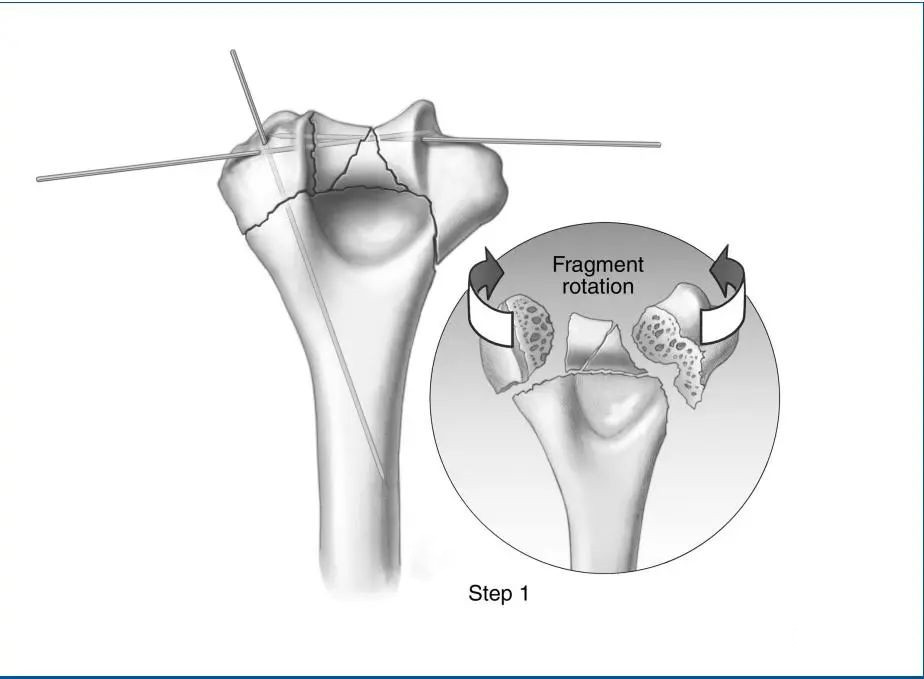
The second step: steel plate application and temporary fixation. The medial and lateral preformed plates are placed and fixed on the distal humerus, while a smooth 2 mm or 2.5 mm segment is inserted through the No. 2 hole (numbered distal to proximal), epicondyle, and distal bone fragment in each plate. Pins to maintain the temporary fixation of the plate and the distal fracture. A screw was placed in the slotted hole (hole 5) in each plate, but not fully tightened, leaving some freedom for the plate to move proximally during compression. Since the lower surface of each plate is tubular at the metaphyseal and diaphyseal ends, only slight tightening of the screws in the slotted holes provides good temporary fixation of the entire distal humerus.
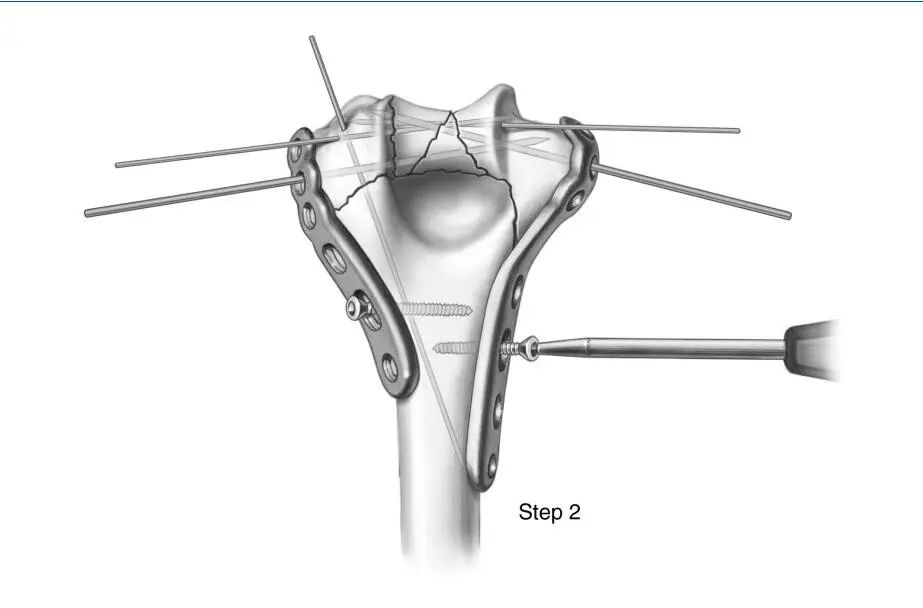
Step 3: Joint fixation. The screw is passed through the No. 1 hole in the lateral plate, through the distal articular fragment from lateral to medial, and tightened. Repeat this step using hole number 3 on the inside. In younger patients, 3.5 mm cortical screws are used (to prevent fractures), while in osteoporotic patients, 2.7 mm long screws are used. The distal screw should be as long as possible and should pass through as many fragments as possible.
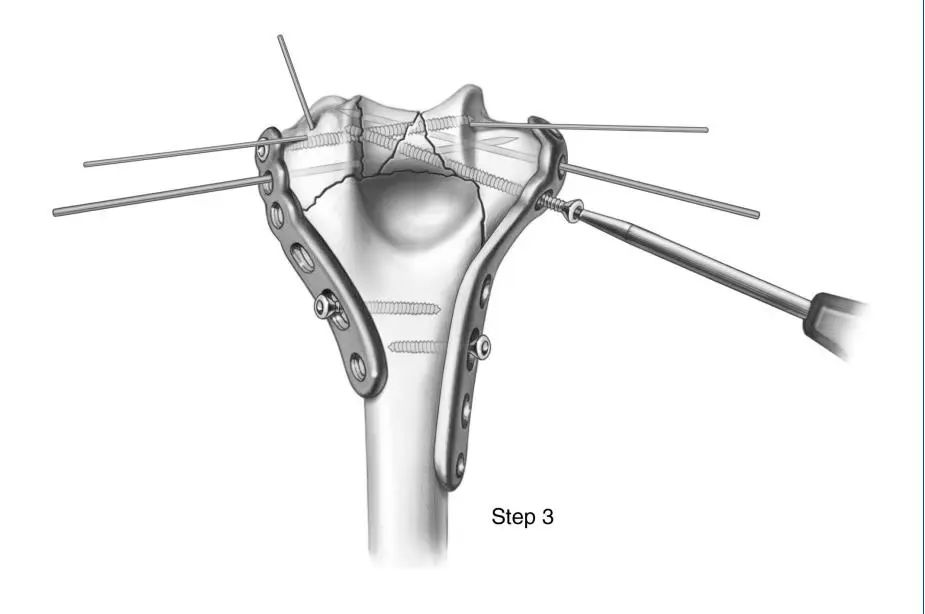
Step 4 A: Compression on the condyle. Interfragmentary compression across the fracture is provided at the suprahumeral level using large reduction forceps, with the lateral column fixed first. Place a screw in hole 4 in the lateral plate in dynamic compression mode (inset). Tightening it further enhances the interfragmentary compression (arrow) at the supracondylar level, causing some stretch (arrow) on the medial supracondylar ridge.
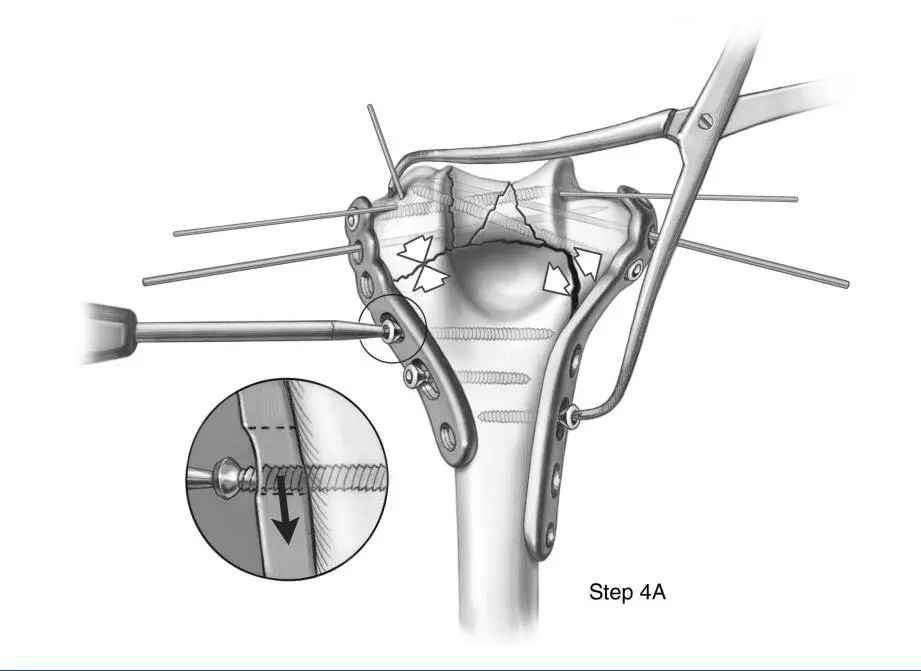
Step 4B: In a similar fashion, use large reduction forceps to compress the medial column and insert the screw into the medial plate in dynamic compression mode. If the profile of the plate is slightly suboptimal, a large bone clamp can be used to press it against the metaphysis to further compress the condyle.
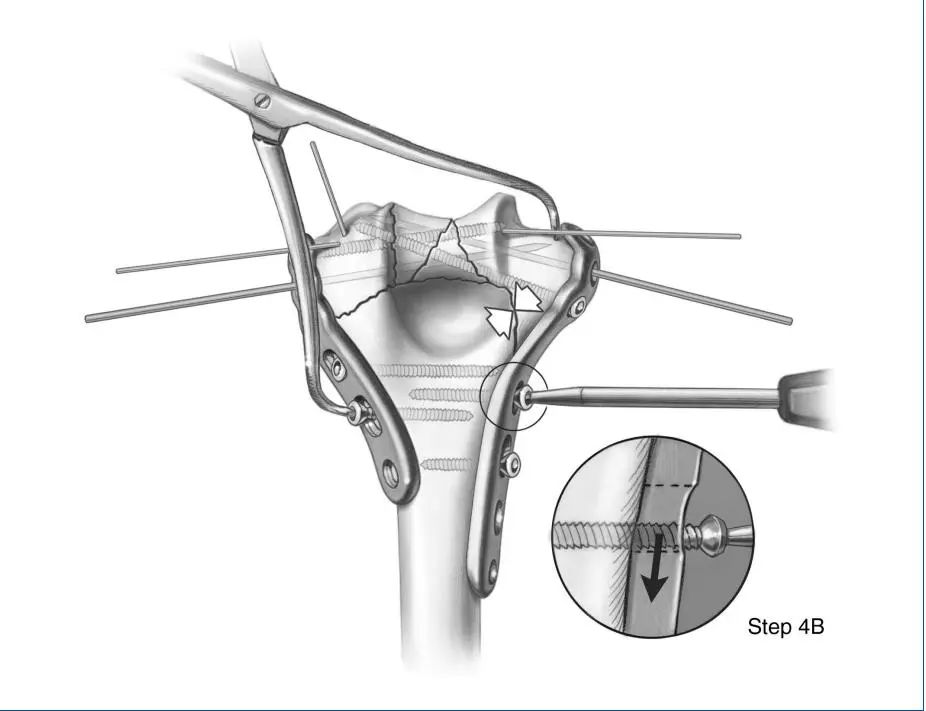
Step 5: Final fixation. The K-wires were removed and the remaining screws were inserted. The distal screws are staggered to maximize fixation of the distal joint fragments.
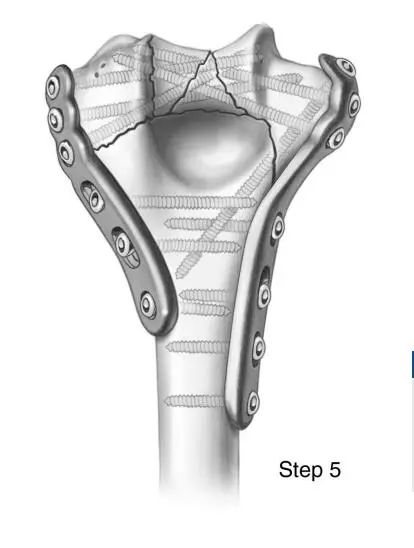
Severe Bone Defect - Supracondylar Shortening
If metaphyseal bone loss or comminution impedes anatomical reconstruction and bone contact is good, the humerus can be shortened at the metaphyseal fracture site with proper overall alignment and geometry of the distal humerus. We call this alternative reconstruction technique supracondylar shortening. This technique is particularly useful in cases of combined soft tissue and bone loss. Shortening ≤1 cm has little effect on the extension force of the triceps terminal, and in cases of severe soft tissue and bone loss, shortening of up to 2 cm can be tolerated without severely affecting elbow biomechanics.
Reshape the distal end of the humeral shaft (excluding the articular segment) to enhance the contact between the distal articular segment and the diaphysis. Usually, only a small amount of bone is removed from the distal end of the humeral shaft, and sometimes from one side of it. B and C, shortened by the fracture site to allow interfragmentary compression between the trochlear and distal diaphysis, between the capitulum and distal diaphysis, and from side to side. Once these surfaces are compressed and secured with steel plates, the stability is strong enough for immediate movement and repair. The distal segment can be translated medially or laterally, or slightly anteriorly, while maintaining rotational and valgus alignment.
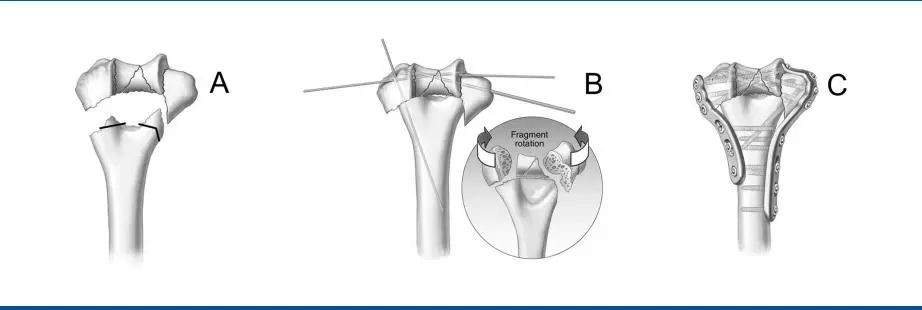
6 screws and 2 plate fixation targets
screw
1: Each screw goes through the steel plate.
2: Each screw should fix the contralateral fracture fragment.
3: Place a sufficient number of screws in the distal fracture segment.
4: Each screw should be as long as possible.
5: Each screw should fix as many fragments as possible.
6: The screws should lock together by crisscrossing, creating a structure with a fixed angle.
Steel plate:
1: For plates used for fixation, compression goals should be achieved at the level of the femoral condyles of the double column.
2: The steel plate used must be strong and rigid enough to resist fracture or bending.
How to Buy Orthopaedic Implants and Orthopaedic Instruments?
For CZMEDITECH, we have a very complete product line of orthopedic surgery implants and corresponding instruments, the products including spine implants, intramedullary nails, trauma plate, locking plate, cranial-maxillofacial, prosthesis, power tools, external fixators, arthroscopy, veterinary care and their supporting instrument sets.
In addition, we are committed to continuously developing new products and expanding product lines, so as to meet the surgical needs of more doctors and patients, and also make our company more competitive in the whole global orthopedic implants and instruments industry.
We export worldwide, so you can contact us at email address song@orthopedic-china.com for a free quote, or send a message on WhatsApp for a quick response +86-18112515727.
If want to know more information,click CZMEDITECH to find more details.
English
Français
Русский
Español
العربية
Português
Deutsch
italiano
日本語
한국어
Nederlands
Tiếng Việt
ไทย
Polski
Türkçe
አማርኛ
ພາສາລາວ
ភាសាខ្មែរ
Bahasa Melayu
ဗမာစာ
தமிழ்
Filipino
Bahasa Indonesia
magyar
Română
Čeština
Монгол
қазақ
Српски
हिन्दी
فارسی
Kiswahili
Slovenčina
Slovenščina
Norsk
Svenska
українська
Ελληνικά
Suomi
Հայերեն
עברית
Latine
Dansk
اردو
Shqip
বাংলা
Hrvatski
Afrikaans
Gaeilge
Eesti keel
Māori
नेपाली
Oʻzbekcha
latviešu
অসমীয়া
Aymara
Azərbaycan dili
Bamanankan
Euskara
Беларуская мова
भोजपुरी
Bosanski
Български
Català
Cebuano
Corsu
ދިވެހި
डोग्रिड ने दी
Esperanto
Eʋegbe
Frysk
Galego
ქართული
guarani
ગુજરાતી
Kreyòl ayisyen
Hausa
ʻŌlelo Hawaiʻi
Hmoob
íslenska
Igbo
Ilocano
Basa Jawa
ಕನ್ನಡ
Kinyarwanda
गोंगेन हें नांव
Krio we dɛn kɔl Krio
Kurdî
Kurdî
Кыргызча
Lingala
Lietuvių
Oluganda
Lëtzebuergesch
Македонски
मैथिली
Malagasy
മലയാളം
Malti
मराठी
ꯃꯦꯇꯥꯏ (ꯃꯅꯤꯄꯨꯔꯤ) ꯴.
Mizo tawng
Chichewa
ଓଡ଼ିଆ
Afaan Oromoo
پښتو
ਪੰਜਾਬੀ
Runasimi
Gagana Samoa
संस्कृत
Gaelo Albannach
Sepeti
Sesotho
chiShona
سنڌي
Soomaali
Basa Sunda
Wikang Tagalog
Тоҷикӣ
Татарча
తెలుగు
ትግንያውያን
Xitsonga
Türkmençe
संस्कृत
ئۇيغۇرچە
Cymraeg
isiXhosa
ייִדיש
Yorùbá
isiZulu



















